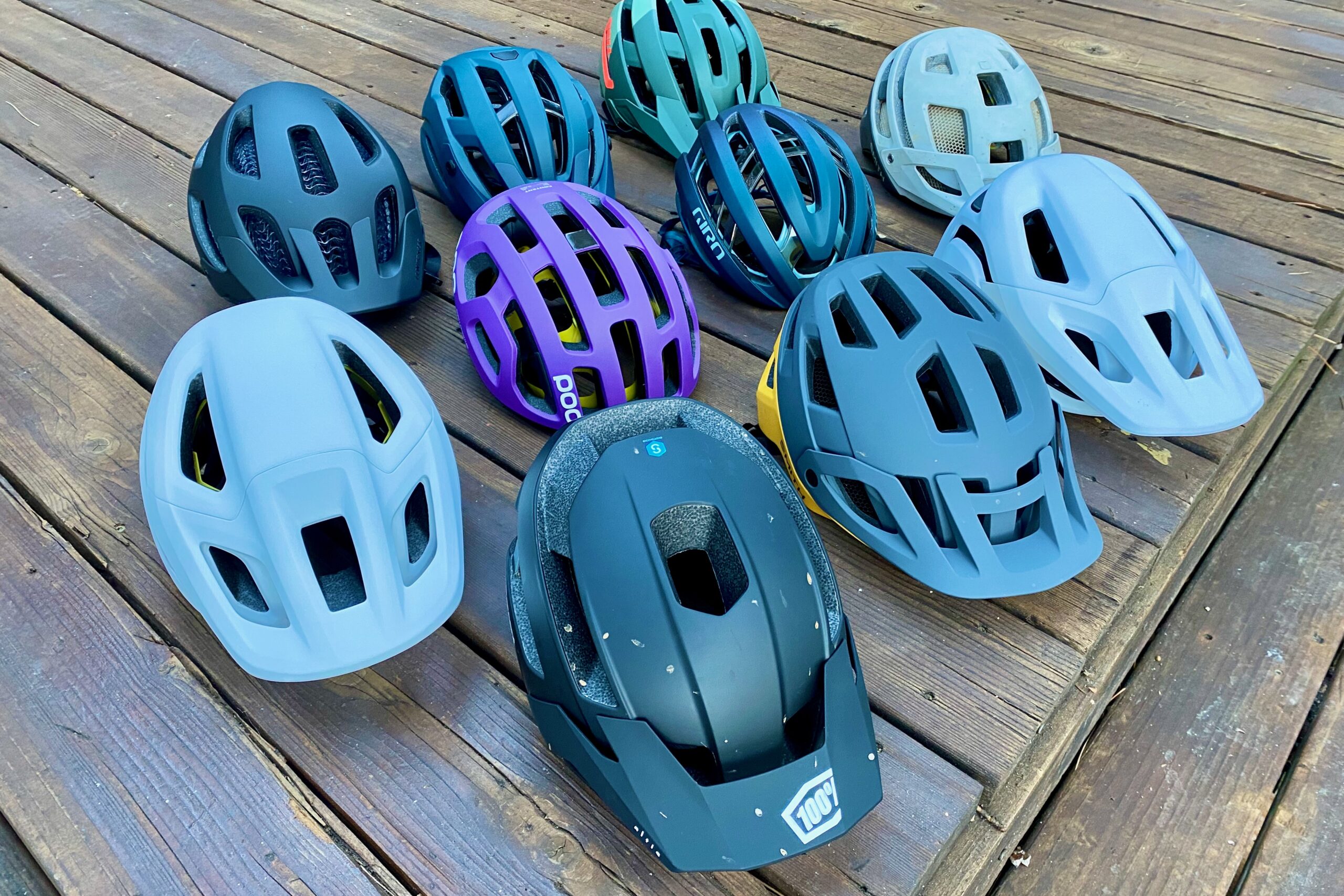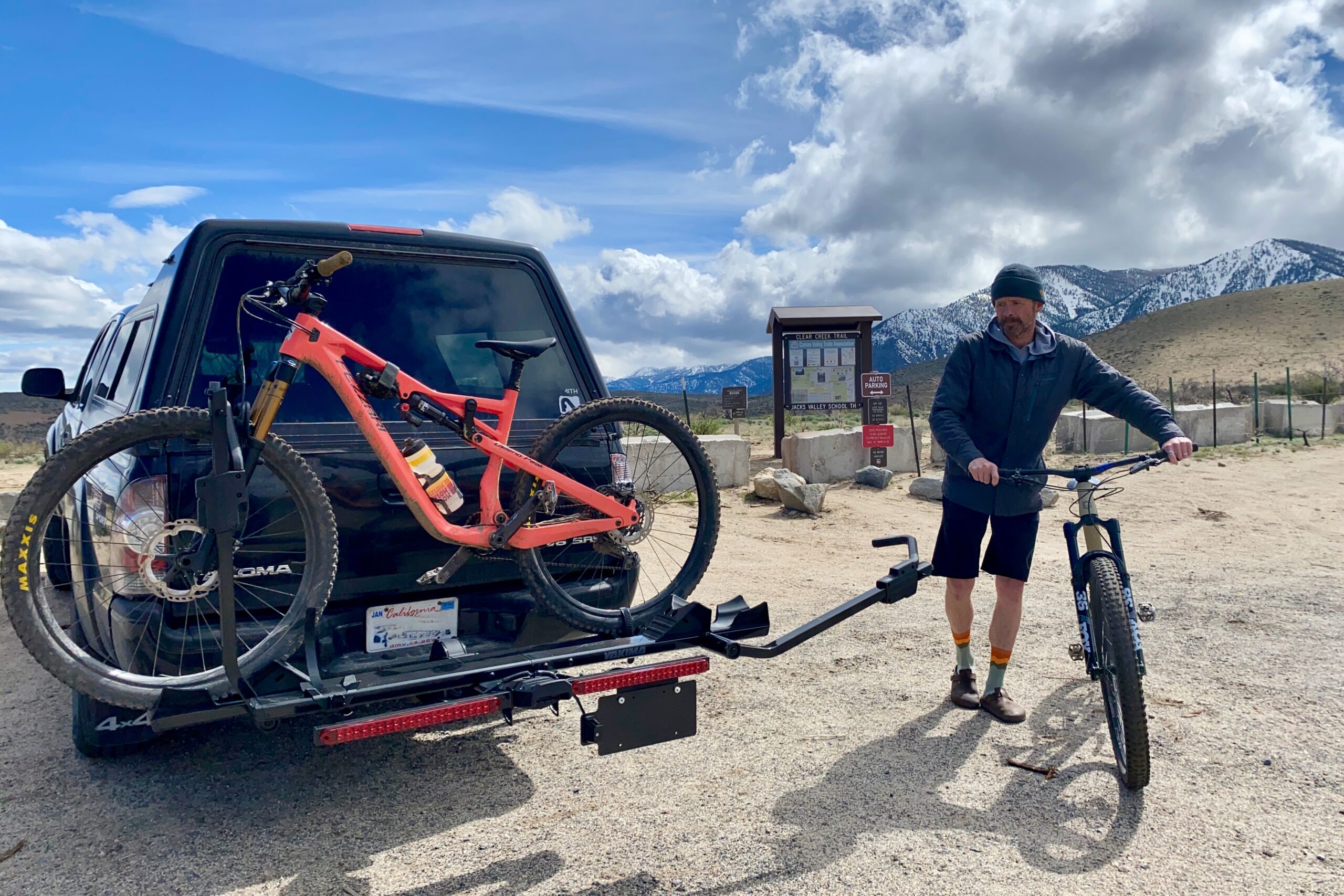The Best Mountain Bike Flat Pedals of 2023
As one of the contact points between you and your bike, pedals are a seemingly simple but critical component for stability and control. Like your grips or your saddle, pedals play an important role in how you feel on your bike – your feet will be on the pedals for nearly all of your riding time, so it is key to find the right flat pedals that work for you, your shoes, and your riding style. And, because most mid to high-end mountain bikes don’t come with pedals, you’ll need to find a pair.
A good mountain bike flat pedal will help you feel confident by providing great traction, predictable mobility, and a supportive platform to ride on. A poor pedal choice can cause your feet to slip around, adding risk to every ride. While most pedals share the same basic design, there are many subtle differences that impact the feel. Small changes in the size, shape, and profile of the platform, or the type of pins and how they are patterned, can have large impacts on how well the pedals work for you and how safe you feel on the bike. Due to the wide range of aesthetics, colors, and platform types available, pedals are also a relatively low-cost way to customize your bike and add some personal flair.
We spent months testing a wide variety of the top pedals available across all price points and analyzing them based on the platform (size, shape, pin layout, aesthetics, and finish), traction/grip, mobility (repositioning the feet), serviceability, and weight. The right set of pedals for you depends on your foot size, the shoes you ride in, the terrain you ride on, and your riding style, but we’ve chosen our favorites overall and those that excel in specific ways like traction, mobility, innovation, and value based on these categories.
Our top recommendations are listed below, followed by the best of the rest which are all still worthy choices. To compare the models we tested at a glance, check out our comparison chart. If you need help deciding what to buy, take a look at our buying advice or our FAQ section for answers to common questions.
The Best Mountain Bike Flat Pedals of 2023
- Best Overall Mountain Bike Flat Pedals: Wolf Tooth WaveForm
- Best Budget Mountain Bike Flat Pedals: OneUp Components Composite
- Runner-Up Best Mountain Bike Flat Pedals: Race Face Atlas
- Best Convex Mountain Bike Flat Pedals: OneUp Components Aluminum
- Best Mountain Bike Flat Pedals for Traction: Chromag Dagga
- Runner-Up Best Mountain Bike Flat Pedals for Traction: Nukeproof Horizon Pro Sam Hill Enduro
- Best Mountain Bike Flat Pedals for Foot Mobility: PNW Loam Alloy
- Most Innovative Design: Pedaling Innovations Catalyst
The Best Mountain Bike Flat Pedals of 2023
Wolf Tooth WaveForm
Specs
- MSRP $200
- Usable Platform Size (L x W, measured) Small (tested): 105.5 x 97.3mm. Large: 115 x 105mm.
- Thickness (Min/Max) 12.5/14mm
- Pins Per Side 11
- Profile Dual Concave
- Measured Weight 377 grams
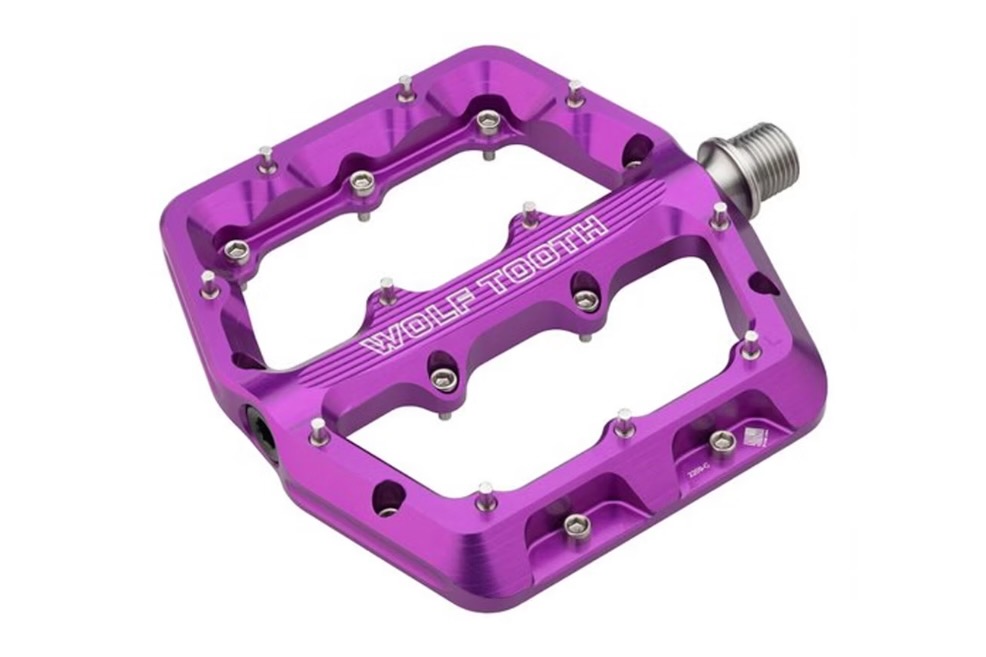
Pros
- Dual concave platform + central pins = above average grip and reliable traction
- Rare balance of great mobility and above average grip
- Beautiful machining and attention to detail
- Easy service and readily available replacement parts
- Low weight
Cons
- Very expensive
- Q-factor is on the narrower side
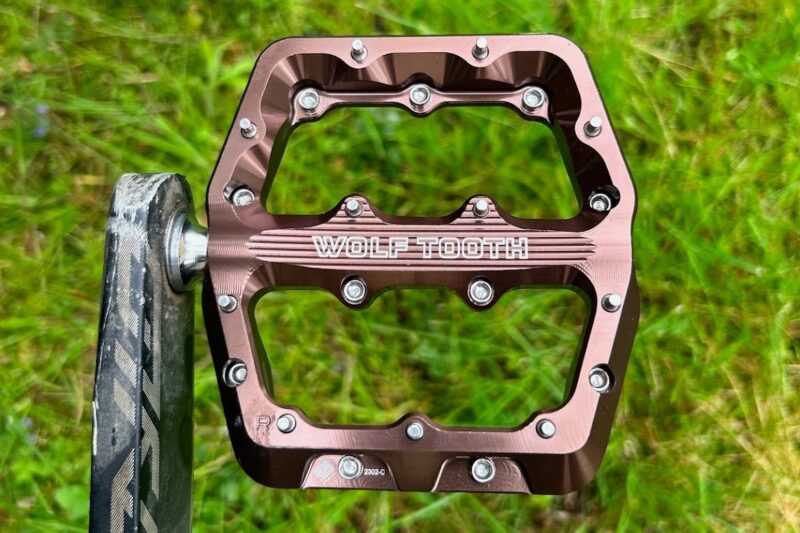
OneUp Components Composite
Specs
- MSRP $60
- Usable Platform Size (L x W, measured) 112 x 105mm
- Thickness (Min/Max) 13.2/18.6mm
- Pins Per Side 10
- Profile Convex
- Measured Weight 368 grams
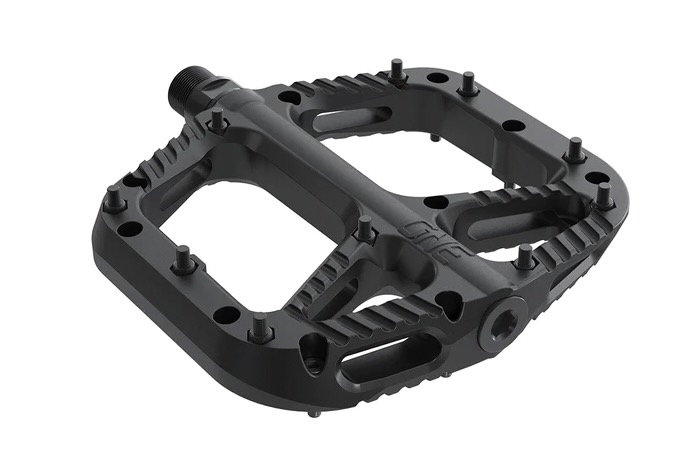
Pros
- Great value
- Solid mobility and consistent grip in most foot positions
- Composite platform hides scarring
- Easy service
- Lightweight
Cons
- Average Traction
- No extra pins included
- Buyers remorse for more expensive past pedal purchases
- On the thicker side
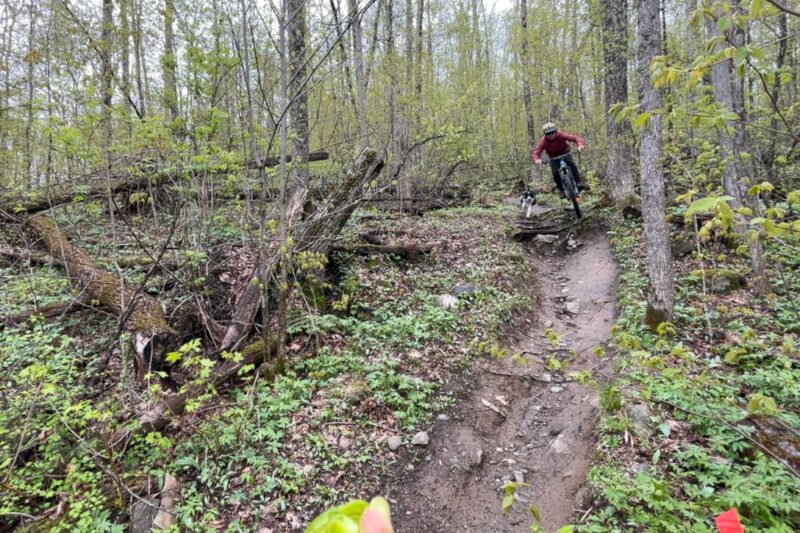
Race Face Atlas Pedals
Specs
- MSRP $180
- Usable Platform Size (L x W, measured) 111.3 x 106.3mm
- Thickness (Min/Max) 11.8/12.5mm
- Pins Per Side 10
- Profile Concave
- Measured Weight 381 grams
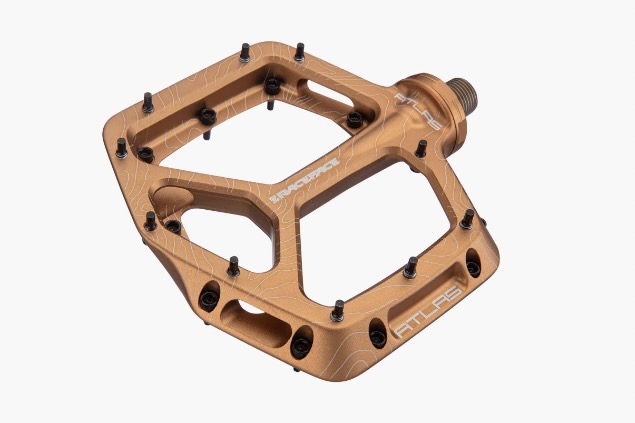
Pros
- Great grip and locked in feel through concave profile and tall pins
- Thin, light, well designed platform
- Lifetime warranty, crashes included
- Easy light service (clean and regrease) process
Cons
- Average foot mobility – the Atlas is for riders who prioritize traction
- Relatively high price point
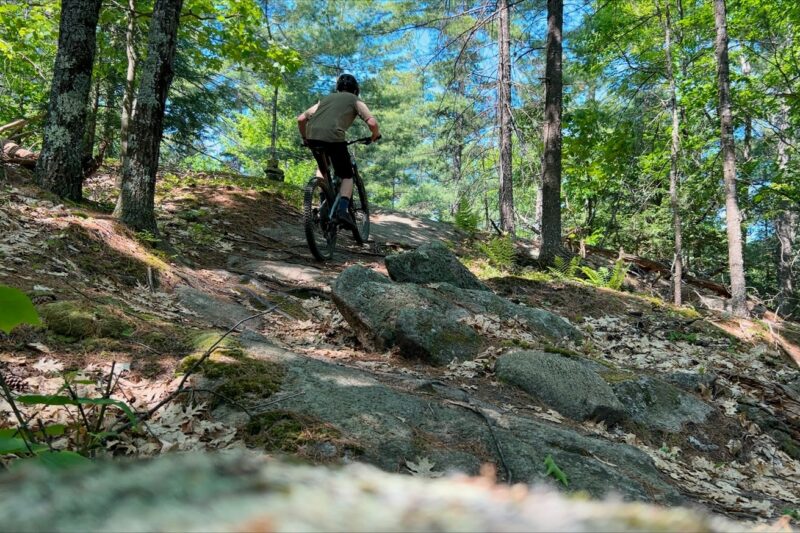
OneUp Components Aluminum
Specs
- MSRP $145
- Usable Platform Size (L x W, measured) 114.6 x 102.3mm
- Thickness (Min/Max) 8.3/12mm
- Pins Per Side 10
- Profile Convex
- Measured Weight 389 grams
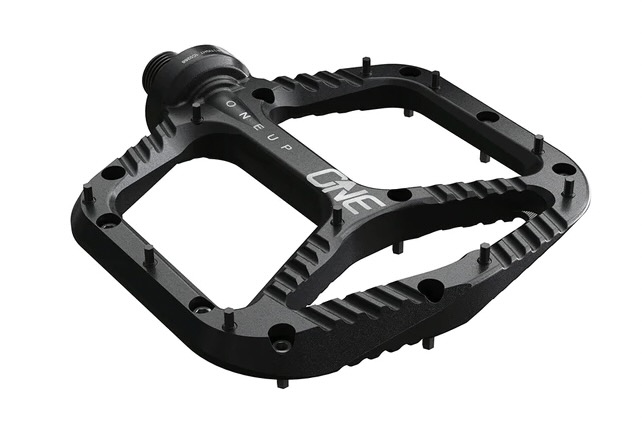
Pros
- Solid, dependable grip
- Forgiving to foot positioning
- Thin, beveled platform with average size footprint
- Versatile convex platform
- Consistent performance across all categories at a moderate price point
Cons
- Concave pedal fanatics may balk at the convex profile, but it’s comparably grippy and worth a try.
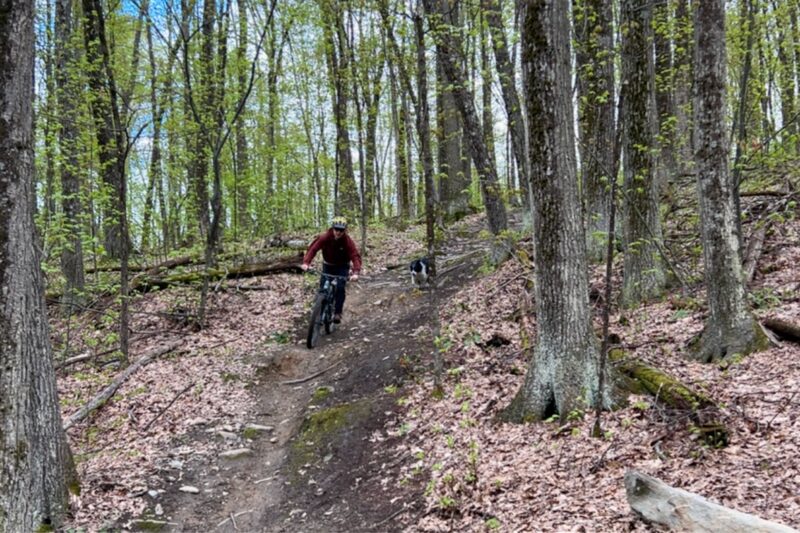
Chromag Dagga
Specs
- MSRP $172
- Usable Platform Size (L x W, measured) 115.4 x 109.7mm (approximately, factoring out extension to axle as non-usable width)
- Thickness (Min/Max) 14.2/16mm
- Pins Per Side 12
- Profile Concave
- Measured Weight 496 grams
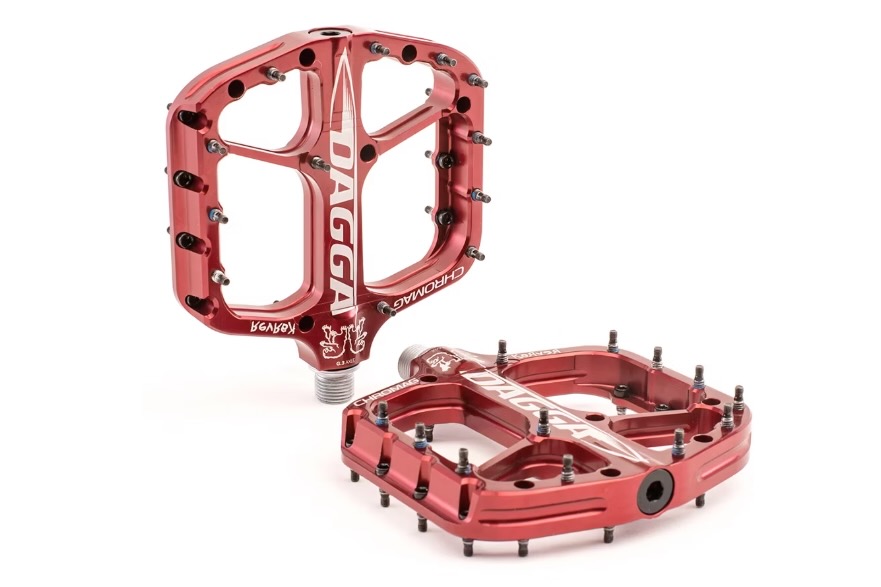
Pros
- Incredible, best in class grip
- Smart pin placement
- Large platform with reliable grip in all positions
- Easy Service.
Cons
- On the heavier side
- Relatively expensive
- Low mobility for foot repositioning
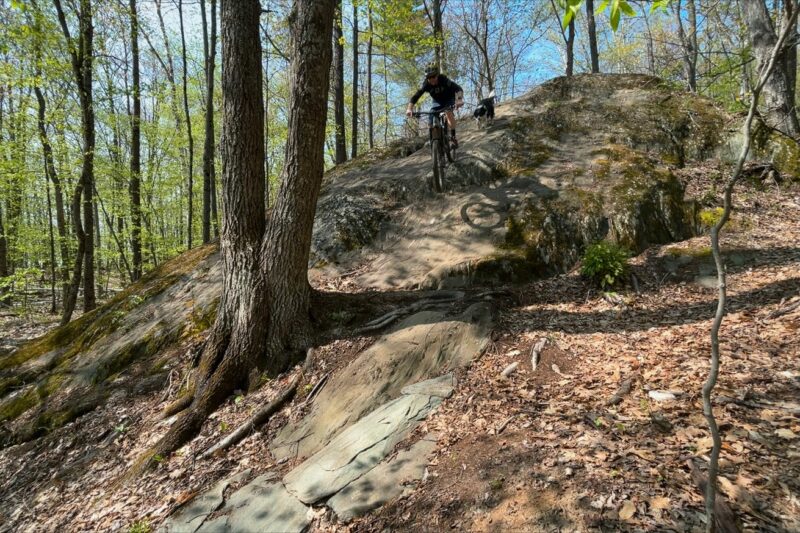
Nukeproof Horizon Pro Sam Hill Enduro
Specs
- MSRP $136
- Usable Platform Size (L x W, measured) 100.5 x 99.3mm
- Thickness (Min/Max) 16/17.4mm
- Pins Per Side 10
- Profile Concave
- Measured Weight 424 grams
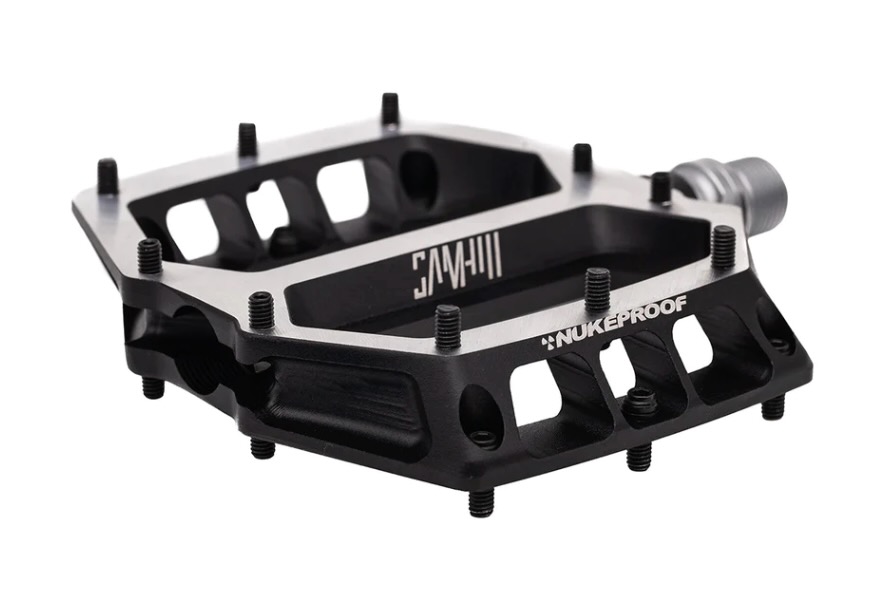
Pros
- High amount of traction and precise feel
- Clean design – they look great
- Standard pins that you can find at a hardware store
- Easy Service
- Moderate price point
Cons
- Smaller platform size will not be for everyone
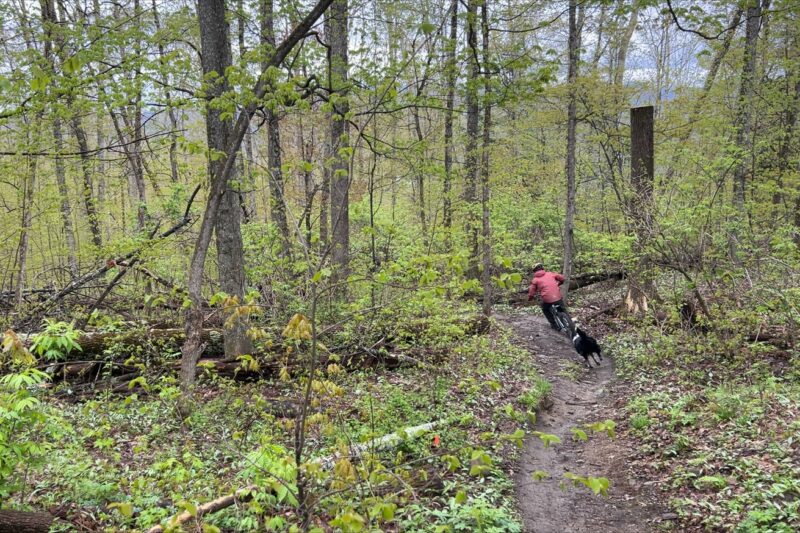
PNW Loam Alloy Pedals
Specs
- MSRP $99
- Usable Platform Size (L x W, measured) 115.6 x 104.4mm
- Thickness (Min/Max) 10.3/16mm
- Pins Per Side 11
- Profile Convex
- Measured Weight 443 grams
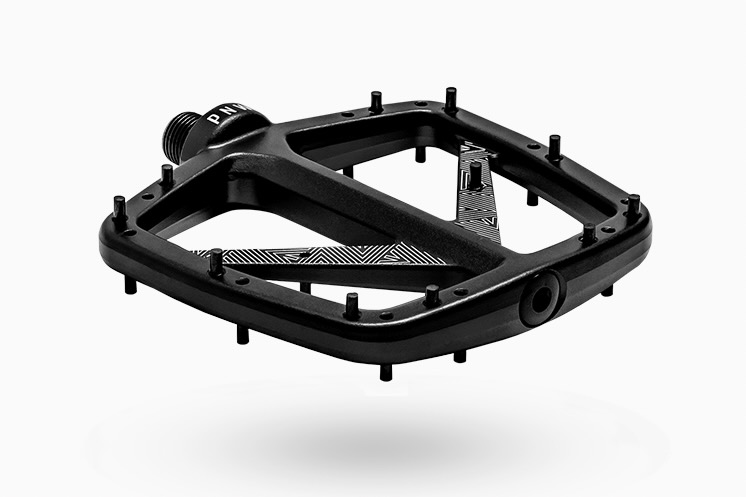
Pros
- Great mobility and very forgiving with regard to foot positioning
- Easy to service with hex keys
- Reliable traction
Cons
- On the heavier end of the spectrum
- Feels large (maybe personal)
- Not a locked-in feel
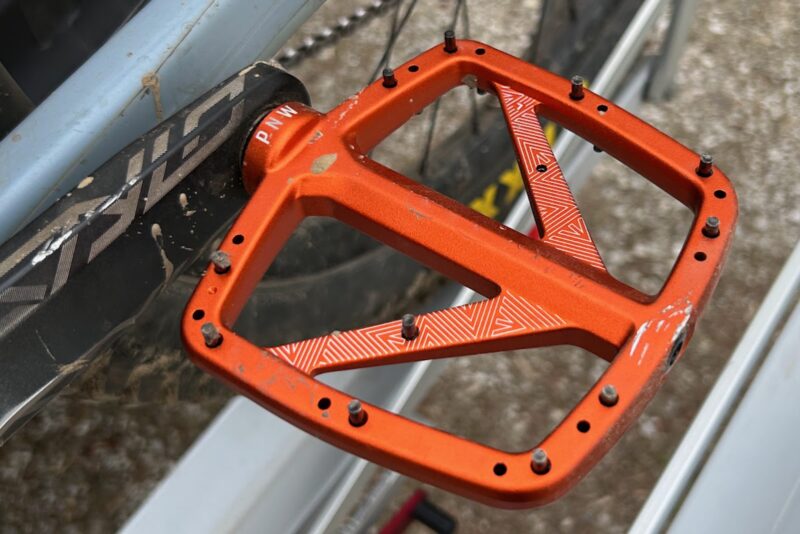
Pedaling Innovations Catalyst One
Specs
- MSRP $150
- Usable Platform Size (L x W, measured) 128.2 x 95.2mm
- Thickness (Min/Max) 16mm
- Pins Per Side 18
- Profile Flat
- Measured Weight 524 grams
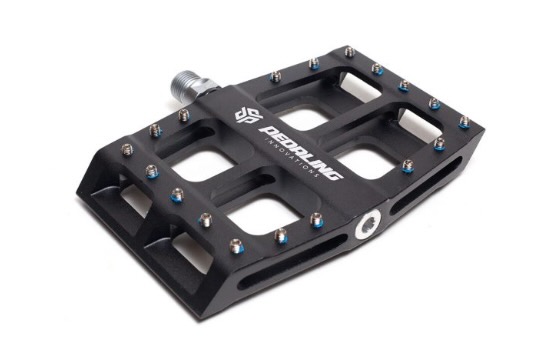
Pros
- Stable, supportive, and comfortable, as advertised
- Increased confidence at speed and efficient weight transfer when cornering
- Innovative and unique approach in a relatively stagnant space
- Best choice if you have big feet or experience foot pain after riding.
Cons
- Adjustment period required
- “Clumsy” feel in very active, slower speed technical terrain
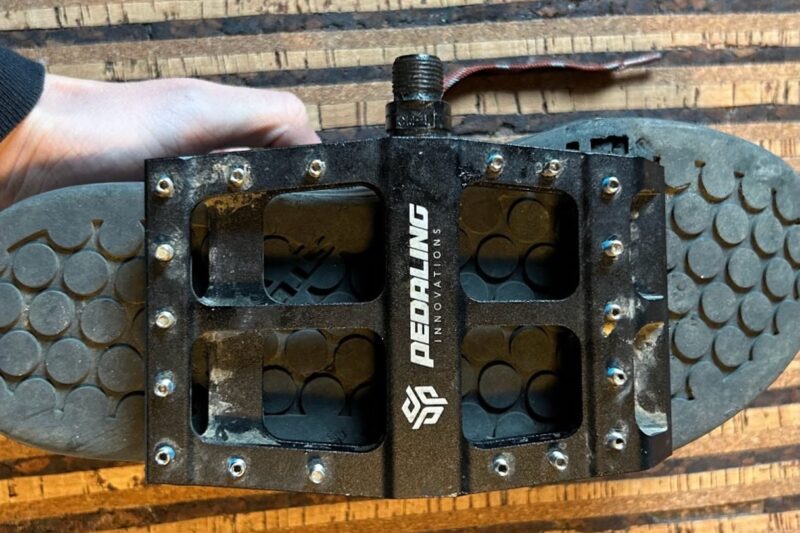
HT Supreme ANS10
Specs
- MSRP $120
- Usable Platform Size (L x W, measured) 100.5 x 101mm
- Thickness (Min/Max) 14.5/17.2mm
- Pins Per Side 10
- Profile Concave
- Measured Weight 375 grams
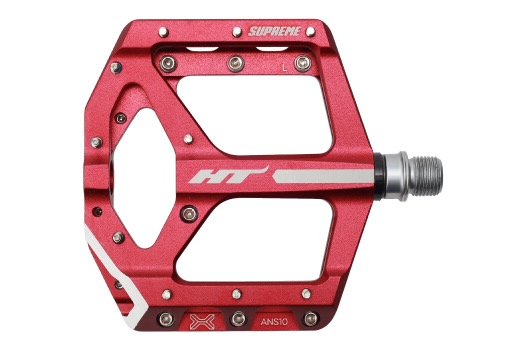
Pros
- Great, best in class traction – when you are in the right position
- Relatively reasonable $120 price tag
Cons
- Inconsistent grip depending on foot position and difficulty finding the sweet spot
- Not for riders seeking rotational float and easy repositioning
- Not the easiest to service
Deity TMAC
Specs
- MSRP $180
- Usable Platform Size (L x W, measured) 110.2 x 105.2mm
- Thickness (Min/Max) 14.5/18.8mm
- Pins Per Side 14
- Profile Concave
- Measured Weight 448 grams
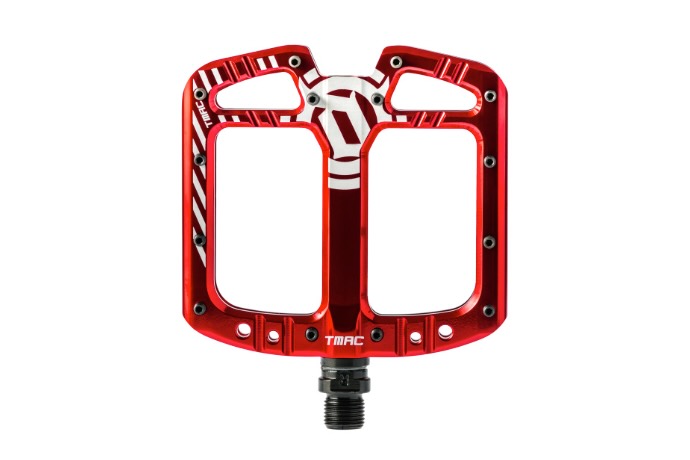
Pros
- Average sized platform
- Above average grip
- High concavity
- Flawless high polish finish
Cons
- Sensitive to foot position
- Low mobility – easy to get “stuck” on
- Top Loading Pins
Crankbrothers Stamp 7
Specs
- MSRP $180 (silver edition we tested: $190)
- Usable Platform Size (L x W, measured) Small (tested): 95.3 x 101.8mm, Large: 114 x 11mm
- Thickness (Min/Max) 11.0/13.4mm
- Pins Per Side 10
- Profile Concave
- Measured Weight 353 grams
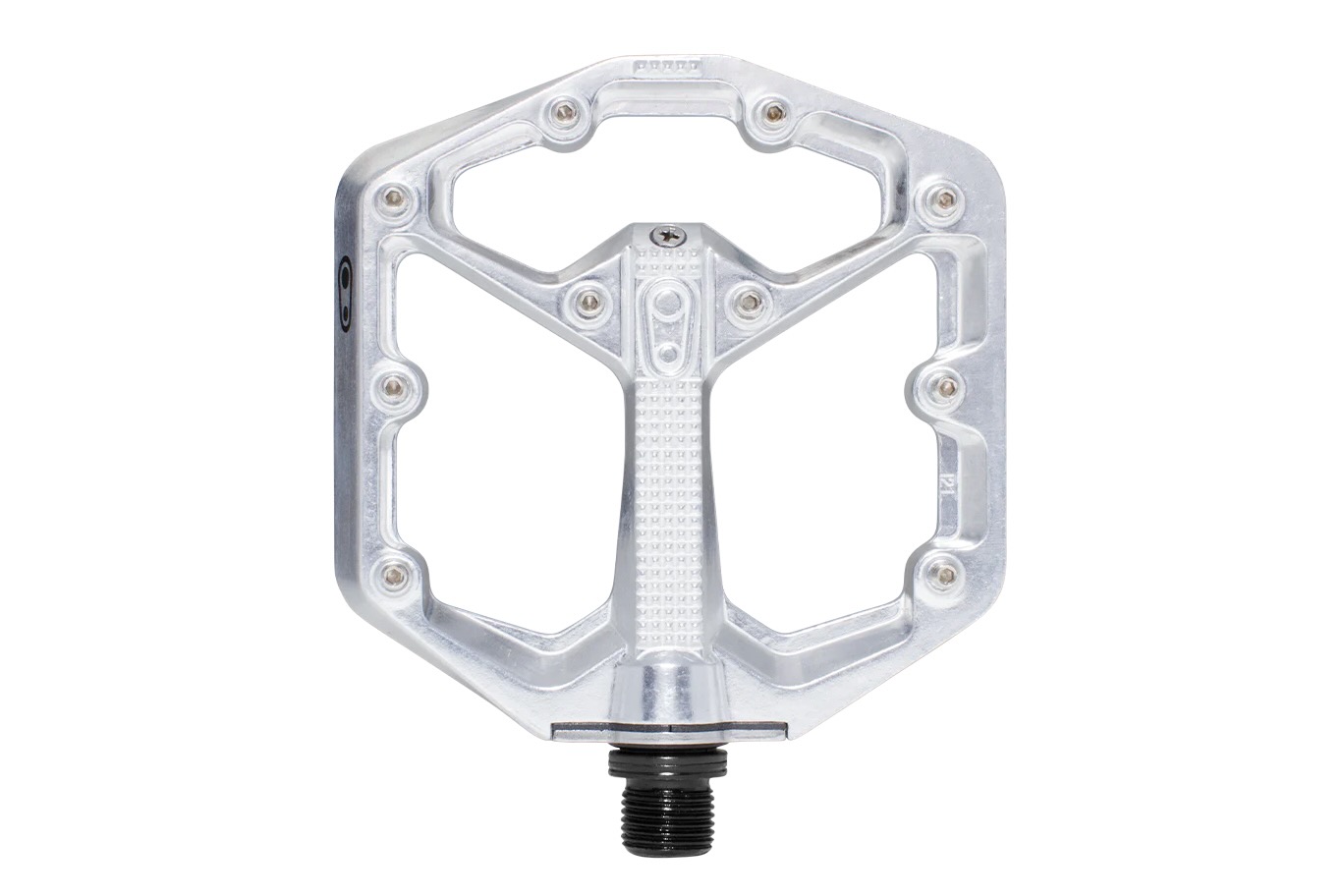
Pros
- Lightest pedal in our test
- 2 sizes of platform available
- Average performance across platform and on trail categories
Cons
- Unique Service Process – you’ll love it or hate it
- Average on trail performance (traction and mobility) at a high price point
Deity DefTrap
Specs
- MSRP $55
- Usable Platform Size (L x W, measured) 112.7 x 103.3mm
- Thickness (Min/Max) 18/20.4mm
- Pins Per Side 10 (8 metal, 2 fixed composite studs)
- Profile Concave
- Measured Weight 400 grams
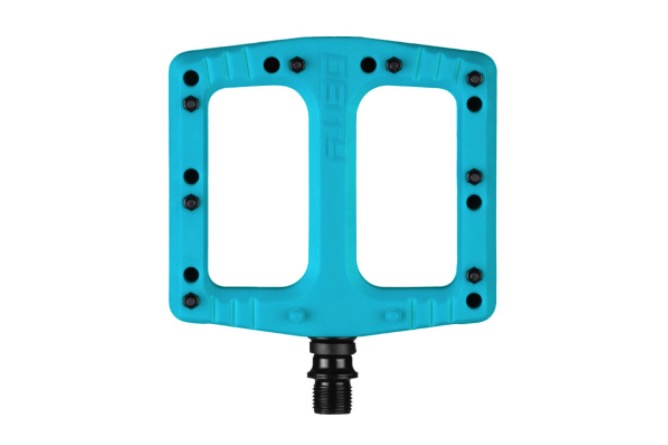
Pros
- Larger platform
- Average performance across all categories
- Very affordable
Cons
- Very basic design and aesthetics
- No outstanding features or performance differentiators
- Some composite pins that cannot be replaced
Comparison Chart
| Pedal Model | MSRP | Measured Usable Platform Size (L x W) | Thickness (min/max) | Pins per side | Profile | Weight |
|---|---|---|---|---|---|---|
| Wolf Tooth WaveForm | $200 | Small: 105.5 x 97.3mm, Large: 115 x 105mm | 12.5/14mm | 11 | Dual Concave | 377g |
| OneUp Components Composite | $60 | 112 x 105mm | 13.2/18.6mm | 10 | Convex | 368g |
| Race Face Atlas | $180 | 111.3 x 106.3mm | 11.8/12.5mm | 10 | Concave | 381g |
| OneUp Components Aluminum | $145 | 114.6 x 102.3mm | 8.3/12mm | 10 | Convex | 389g |
| Chromag Dagga | $172 | 115.4 x 109.7mm | 14.2/16mm | 12 | Concave | 496g |
| Nukeproof Horizon Pro Enduro | $136 | 100.5 x 99.3mm | 16/17.4mm | 10 | Concave | 424g |
| PNW Loam Alloy | $99 | 115.6 x 104.4mm | 103/16mm | 11 | Convex | 443g |
| Pedaling Innovations Catalyst One | $150 | 128.2 x 95.2mm | 16mm | 18 | Flat | 524g |
| HT Supreme ANS10 | $120 | 100.5 x 101mm | 14.5/17.2mm | 10 | Concave | 375g |
| Deity TMAC | $180 | 110.2 x 105.2mm | 14.5/18.8mm | 14 | Concave | 448g |
| Crankbrothers Stamp 7 | $180 | Small: 95.3 x 101.8mm, Large: 114 x 111mm | 11/13.4mm | 10 | Concave | 353g |
| Deity DefTrap | $55 | 112.7 x 103.3mm | 18/20.4mm | 10 | Concave | 400g |
Why Should You Trust Bikerumor?
At Bikerumor, we’ve been reporting on the latest cycling news, technology, and products for over a decade. Our team is made up of passionate riders that span all disciplines of cycling and have their fingers on the pulse of the industry. For our buyer’s guides, we’ve sought out qualified individuals to test and review products side by side to form the basis for our comparisons and recommendations.
Our mountain bike flat pedal review author, Paul Clauss, is a talented mountain biker who has been riding almost his entire life. Hailing from Essex Junction, VT, Paul has great access to quality, technical trail riding with ample roots and rocks that make for great flat pedal testing conditions. He is a mechanical engineer with experience working with 3D printing and CNC manufacturing processes on a variety of products including bike frames and components. This background gives him unique insight into bike components and technologies and an excellent ability to tease out the subtle performance differences between the products he tests. In this role, Paul gets to combine his discerning tastes and love for writing into detailed reviews that will hopefully help you find the best products for your needs.
After scouring the market for the best mountain bike flat pedals available in 2023, we rounded up a diverse selection of 12 models for side-by-side testing and comparison. Each model was tested in conditions ranging from wet to dry with equal parts climbing and descending. Often, models were swapped out mid-ride for back-to-back comparison. A pair of well-broken-in Five Ten Freerider Pro shoes was used with all of the pedals tested for consistency on Paul’s Santa Cruz Bronson and Chromag Wideangle hardtail mountain bikes. Each model was judged on a number of performance characteristics including platform, traction/grip, foot mobility, serviceability, and weight to determine our favorites.
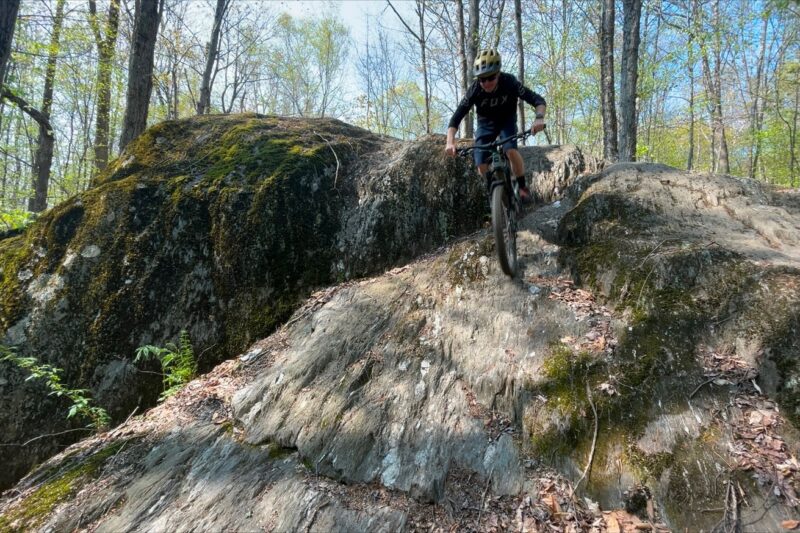
Buying Advice: How to Choose Mountain Bike Flat Pedals
When it comes to choosing a pair of mountain bike flat pedals, there are a lot of options. Individual preferences and needs vary, of course, but thankfully so do the pedals we tested. As one of your key contact points on the bike, there are a few variables to consider to help select the best flat pedals for you.
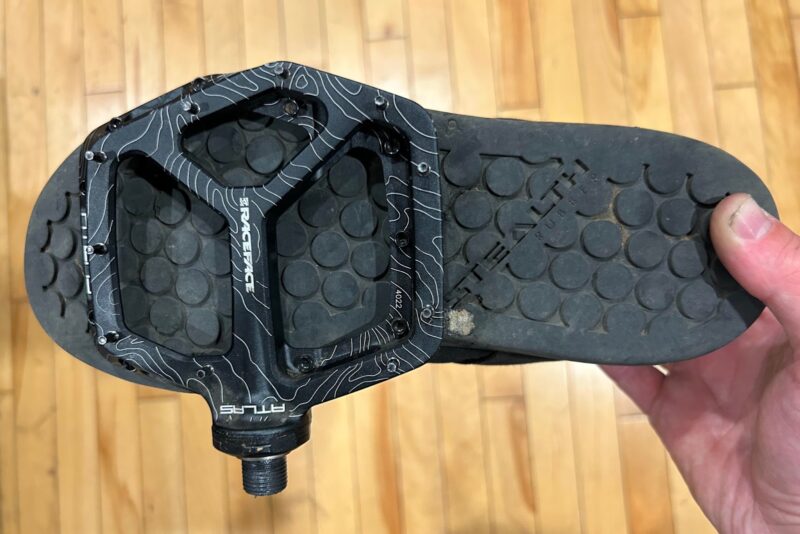
Platform Size
Your shoe size and natural tendency towards in/out-toeing will contact various sizes and shapes of platforms differently. If you have very large feet, you will likely benefit from the support provided by a larger platform, while a smaller platform may work better for smaller-footed folks. If you like to hang your feet off the outside of the platform, pentagonal or rectangular shapes may give better support for the outside of your foot than a hexagonal shape. If your feet are sore after riding, consider how your foot engages the pedal when you are in your pedaling position on the bike and look for a size and shape that optimizes support throughout your foot.
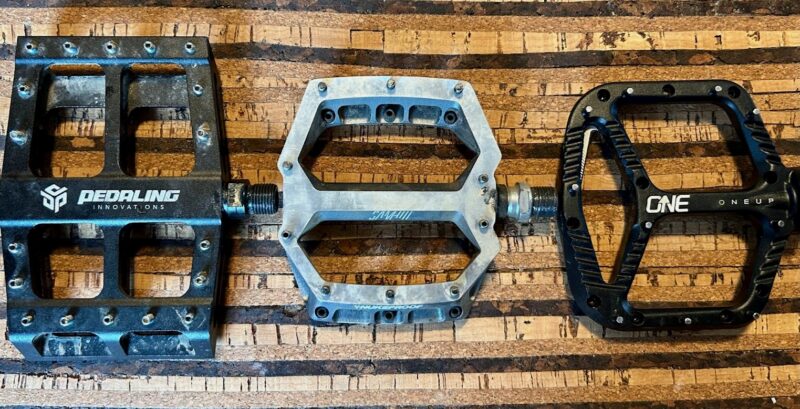
Pedal Sizes
It stands to reason that people with smaller feet may not need the same size platform as those with larger feet, so some flat pedals are offered in different sizes with the goal of providing options for different foot sizes. Several brands, like Crankbrothers and Wolf Tooth, offer their pedals in both small and large sizes. For example, Crankbrothers recommends the small version of their Stamp 7 pedal for riders with shoe sizes between 5 and 10 US, and the large version for riders with shoes between 10 and 15 US. Wolf Tooth has a to-scale printable size comparison on their website, which riders can use to determine the best fit of the WaveForm pedals for their shoe’s soles. Other brands make numerous models that often have different size platforms for the same reason. Like anything else, it comes down to personal preference.
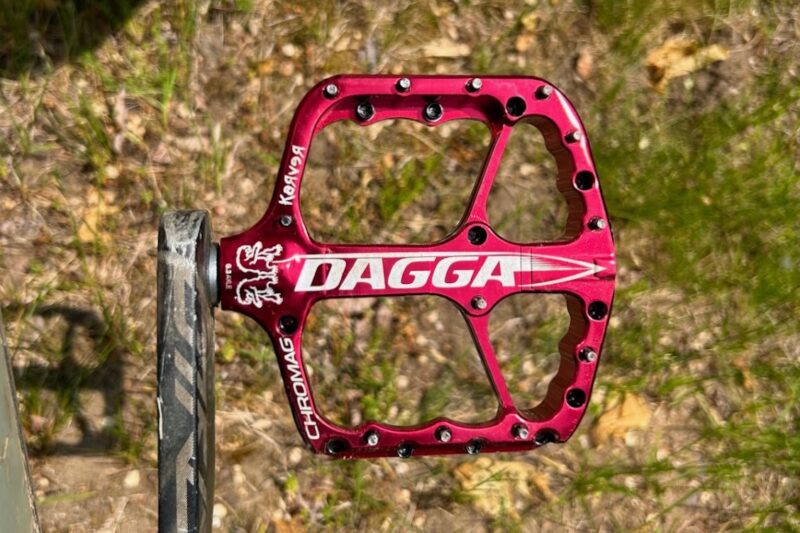
Q-factor
You may also want to consider the q-factor. Q-factor refers to the width of your stance on the bike – technically it is the distance between the pedals at the outside of the cranks. Depending on how close the inner edge of the pedal platform sits in relation to the outside of the crankarm can change the effective q-factor in your normal riding position. If you have wide hips or tend to take a very wide stance, a wider q-factor may be more comfortable. If you ride bulky shoes or a frame with large chain stays or seat stays, a wider q-factor can help you reduce rubbing your foot on the cranks and frame.
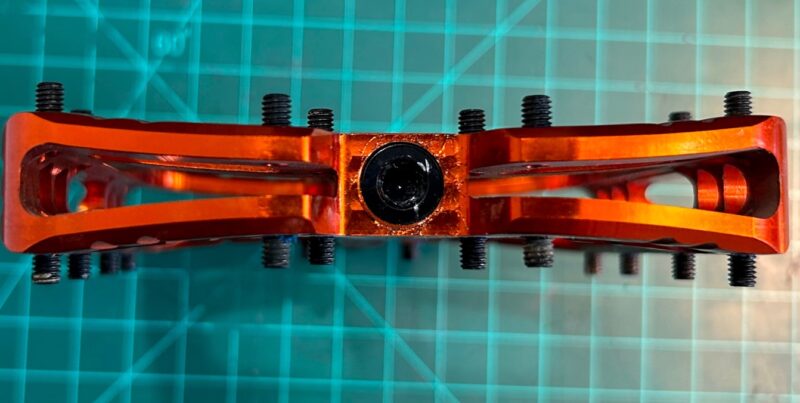
Profile: Concave vs Convex
You’ll also want to consider the platform profile – flat pedals may be concave, convex, or flat. Like anything else, preferences vary, but most riders prefer one or the other. Concave pedals are thicker at the leading and trailing edges and thinner along the axle. This creates a depression in the middle of the pedal for the sole of the shoe to sink into. Examples of concave pedals include the Deity TMAC, Chromag Dagga, Race Face Atlas, and Nukeproof Horizon Pro Enduro, which also happen to be some of the grippiest models we tested.
Convex pedals are slightly thicker at the axle and thinner at the leading and trailing edges. This has the opposite effect of concavity, as it promotes the shoe’s sole flexing slightly over the pedal to achieve maximum grip. In general, we’ve found that the convex design allows for somewhat easier foot mobility, as the pins are easier to release from the sole of the shoe when repositioning.
Perfectly flat profiles are somewhat rare, but the unique Pedaling Innovations Catalyst is an example.
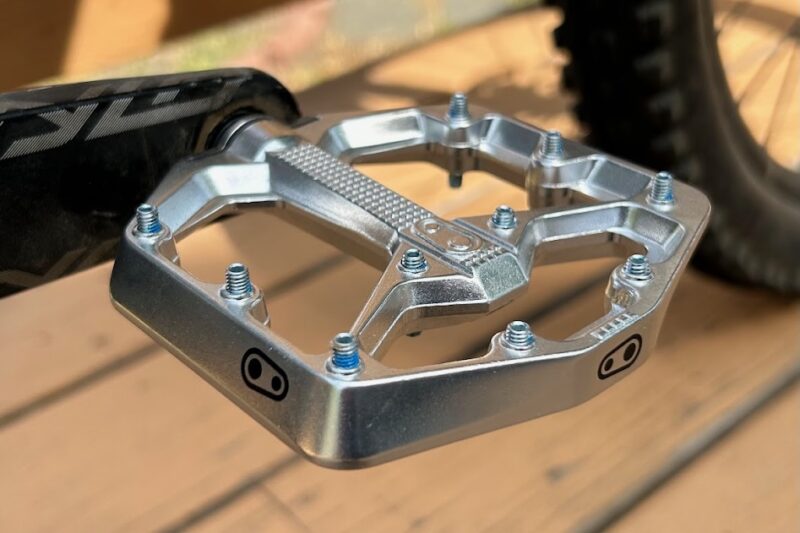
Traction and Grip
The traction provided by a pedal depends on the platform size/shape/profile, the pin layout, and the type of pins. Pin height and placement vary across pedals – some rely on pins placed around the perimeter, some include central pins. Some pedals allow you to adjust the pin height by adding or removing washers while others do not. The combination of these different platforms and layouts changes how much effort you need to spend keeping your feet on the pedals while riding rough terrain. The rubber compound and tread design of the soles of your shoes is also a factor when it comes to grip.
The amount of traction you want from a pedal depends on your riding style and preferences. While a super grippy pedal might be great for riding fast downhill trails, it might be very sensitive to foot position and grip so well that it is difficult to reposition your foot – there are pedals that provide too much grip. The right amount of grip is individual to the terrain you ride and your riding style – if you find yourself struggling to reposition or rotate your feet regularly to feel like you are in the right spot on the pedals, you might want to try a pedal with a bit less overall grip but with a pin pattern, profile, and shape that allows for better mobility and is less sensitive to foot position. Riders coming from clipless pedals will want to pay special attention to rotational float if they are interested in a flat pedal that feels similar to clipping in.
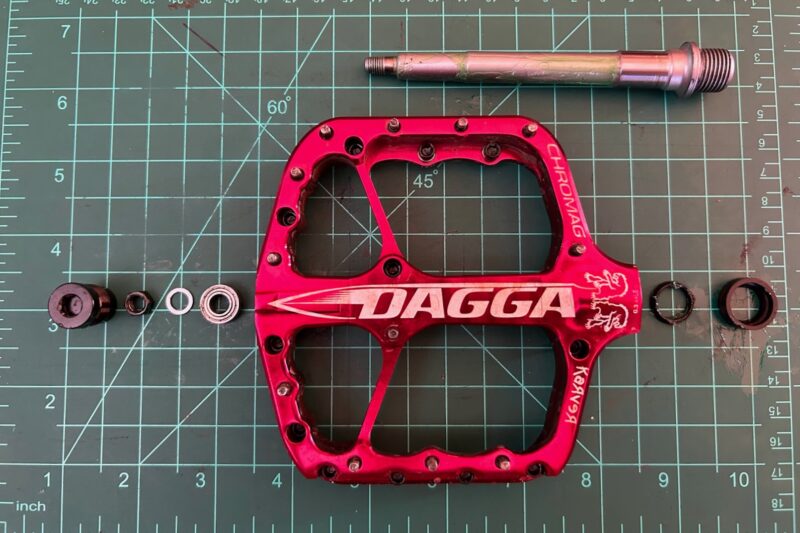
Serviceability
Any time you ride your bike, your pedals put in some serious work. Not only do they support much of your weight at virtually all times, but any time they are spinning, the internal components like bearings and bushings are doing their job. Given their location at the end of the crank arms, under your feet, and close to the ground, they may also be subjected to impacts with trailside obstacles. Hard impacts can damage pedal pins, scratch the pedal body, or even bend the spindles. Despite being a sealed system, water and dust from the trail can make their way into the internals. Of course, how often you ride, how you ride, the terrain where you ride, and the weather conditions in which you ride will play a role in how quickly wear and tear occurs on your pedals.
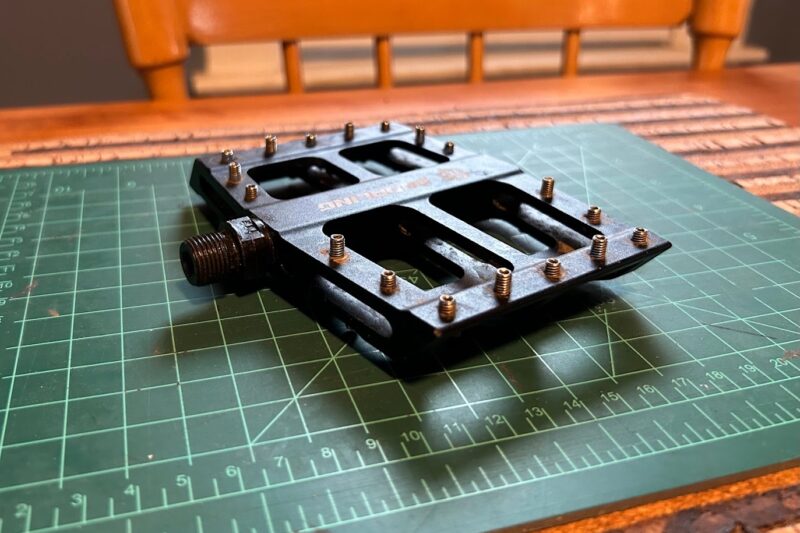
Fortunately, most quality flat pedals are designed to be serviced fairly easily to keep them running smoothly. Basic service procedures generally only involve a few simple tools to pull the spindle from the pedal body for simple cleaning and regreasing. Most brands sell bearing and bushing replacement kits and spindles so you can rebuild your pedals should something bend or wear out. Spare pins are often, but not always, included with new pedals so you can replace damaged ones or those that have fallen out, and replacement pin kits are inexpensive and typically easy to find. Typically, you can find an instructional video to guide you through the process. That said, if you are unsure of your mechanic skills or don’t have the tools to do it yourself, most good bike shops can service your pedals for you.
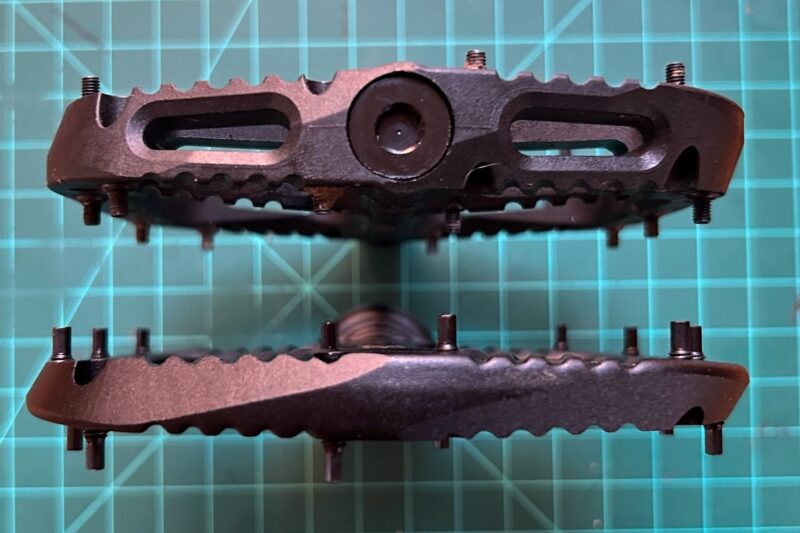
Value
Compared to many other things in mountain biking, pedals are a relatively inexpensive component. And that’s a good thing since you can’t ride a bike without them. Still, the models we tested vary in price pretty dramatically from $55 up to $200. It will depend on how much you ride and how much abuse you put them through, but it’s fair to expect that a pair of pedals should last a couple seasons or longer if taken care of properly. Not surprisingly, the more expensive models are typically made from higher-quality materials and they generally offer higher overall performance than the least expensive options. If you ride every day and have specific performance expectations of your pedals, then it’s probably best to spring for a more expensive pair to meet your needs. If you ride less frequently, less aggressively, or simply can’t justify shelling out the big bucks for the high-end models, the less expensive composite options still perform admirably at a fraction of the price.
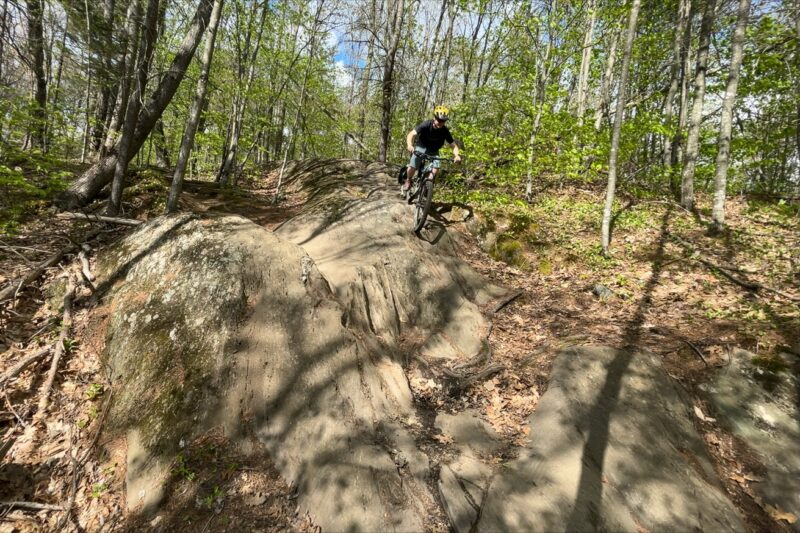
Frequently Asked Questions
The flat vs. clipless debate is one of the biggest in the sport of mountain biking with most riders leaning strongly one way or the other and some people switching between styles depending on the type of riding they are doing. It really comes down to personal preference, and there are pros and cons to each style.
Flat pedals are often the first type of pedal that people ride when they start out mountain biking, and many riders choose to continue riding them as their skills progress for various reasons. Since the connection to the pedal is a result of the interface between the pedal platform, pins, and the sole of your shoes, it is much easier to remove/replace your foot on the pedal when needed. Modern pedal designs have large platforms that provide excellent stability and control and many shoe/pedal combos provide a nearly locked-in feel over rough terrain. Flat pedals also help riders build strong technique for bike handling, particularly with rear wheel lifts or bunny hops. The correct technique for these moves is not relying on using your feet to lift the pedals but using your entire body to move the bike. You’ll notice that most trials riders, freeriders, and dirt jumpers use flat pedals. This is partly due to technique, partly so they can adjust their foot position on the fly, and partly to mitigate risk.
Clipless pedals, on the other hand, rely on a mechanical connection between the sole of your shoe and the pedal. This connection keeps your feet positioned optimally for pedaling and prevents your feet from getting bounced off the pedals in rough terrain. It is also claimed to be more efficient when pedaling, although some people will debate this, because the pedal connection means that you can use your leg power throughout the entire pedal stroke, both pushing down and pulling up. For this reason, you’ll notice that ALL road racers, and MOST mountain bike racers, use clipless pedals, particularly XC racers. For downhill or enduro racing, the argument towards clipless is likely less about pedaling efficiency and more about being locked into the bike on rough terrain – whether you are pedaling through it or not. There is a learning curve, however, as clipping out of clipless pedals requires a deliberate twisting of the foot. Often while learning to use them, awkward crashes and tip-overs are quite common.
This is an individual preference and depends on your riding style. The level of grip you feel when riding flat pedals is impacted by: The shape, size, stiffness, and rubber compound on the sole of your riding shoes. The profile, size, and pin layout of the pedals – how does your shoe engage with the pedal platform? The height and diameter of the pins. In general, taller and narrower/sharper pins will give a more “locked in” feeling, particularly with more spacing between the pins – but this increase in pressure on individual pins can make repositioning your foot difficult.
If possible, try a variety of shapes, profiles, and pin layouts with your favorite riding shoes to find what works best for you. Hop on your friends’ bikes and try to sprint over rough sections to test pedal grip with your shoes and foot positioning throughout your pedal stroke under high stress – this will ensure you are testing the vertical and lateral grip of your shoes on the pedals.
In general, the grippiest pedals are those designed purely for gravity riding like the Deity TMAC, Chromag Dagga, and Nukeprood Horizon Pro. These pedals typically have long, sharp pins, concave profiles, and large platforms to optimize the connection to the sole of the shoe.
All the pedals in this test use either 6 or 8mm Allen (Hex) keys or a 15mm Spanner/Pedal Wrench. You will need the appropriate tool for your pedals and a small amount of general bicycle assembly grease.
When installing pedals, remember that the left pedal is reverse threaded – turn counterclockwise into the crank arm to install. All the pedals in this test have clear markings to indicate their side. An easy way to remember this is that you always rotate pedals forward (towards the front of the bike) to install. Most pedals mark right and left pedals to help avoid installing them on the wrong side. If you are struggling to get the threads to catch, don’t force it or you can risk damaging the threads in your cranks arms.
Flat pedals are a simple part but do require simple, infrequent maintenance. Riding flat pedals, you can generally expect to replace pins to maintain traction and service bearings/axles to keep them spinning smoothly.
Some pedals use standard grub screws for pins that you can find at your local hardware store. Others use customized pins that you will need to order from the pedal manufacturer. If you find yourself smacking roots and rocks often, you may want to consider the ease of replacing pins when selecting pedals.
Installing pins is easy – unscrew the old ones and screw in the new ones. Recessed or sunken pin heads can help you avoid needing to remove bent or damaged pins with vise grips and a good brush will help you remove dirt packed into pins. Some pedals come with replacement pins while others do not. Most pins use a small hex key (1 to 3mm) or a Torx head (T10 or T15) for removal/installation. We recommend using a small amount of thread locker when installing pins to ensure they don’t fall out, like Blue Loctite.
When your pedals are not rotating smoothly, it is time to service/replace the bearings/bushings and axle. For most pedals in this test, rebuild kits are sold by the manufacturers and instructions are typically very easy to find online. This is a relatively straightforward process of removing the pin, checking bearings/bushings, and cleaning/regreasing/repacking or replacing as necessary.
Any modern mountain bike flat pedal shoe will work well with these pedals. Flat pedal shoes are constructed with flat soles, grippy rubber, and tread patterns to optimize the grip provided by common pin patterns and pedal designs. When purchasing flat pedal shoes, consider normal sneaker fit and your preference for a stiff or soft sole. A stiffer sole might be more supportive and reduce foot pain on longer rides while a softer sole may give a better overall grip, particularly when looking for high control at slower speeds. Bear in mind that not all flat pedal shoes are created equal in terms of the grip that their rubber compound or tread pattern provides, and that may also affect your connection to the pedals.
Related Content
The post The Best Mountain Bike Flat Pedals of 2023 appeared first on Bikerumor.

